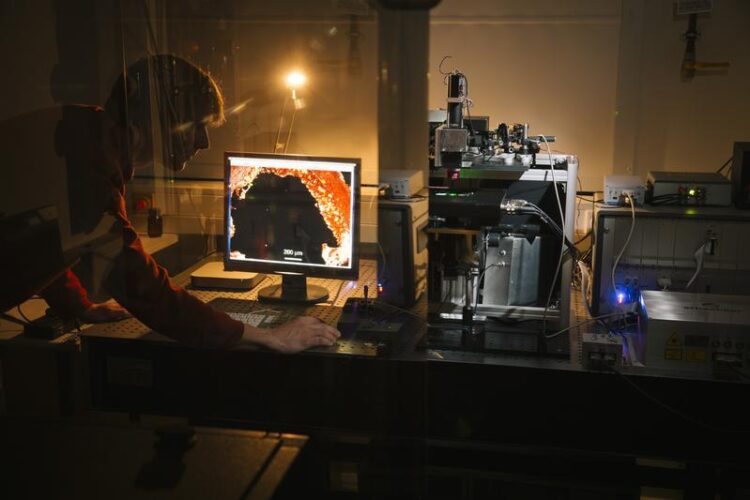Laser light detects tumors

Scientists from Leibniz IPHT are researching laser-based, multimodal imaging techniques to visualize biomolecules in cells, tissues and organs.
Sven Döring / Leibniz-IPHT
How new optical imaging strategies help to improve cancer diagnostics.
A new book provides in-depth description of state-of-the-art optical approaches for the enhancement of earlier cancer detection and classification
Cancer — this diagnosis is hitting more and more people in our aging society. But the earlier the disease is detected, the greater the likelihood that it can be treated effectively. Modern light-based technologies can help to decisively improve the diagnosis and treatment of cancer, because they can produce diagnostically relevant information quickly, reliably and gently.
The recently published book on “Multimodal Optical Diagnostics of Cancer” by the international biophotonics experts Jürgen Popp, Valery V. Tuchin and Valery Zakharov now provides an in-depth description and discussion of the latest optical methods for non-invasive cancer diagnostics and treatment. Researchers in biomedical engineering, photonics and medicine will find the book to be a guide to optical approaches for cancer diagnostics and screening, for long-term monitoring to image-guided intervention.
“Light-based methods are a promising tool to facilitate early detection and diagnosis of cancer,” says Prof. Jürgen Popp, scientific director of the Leibniz Institute of Photonic Technology (Leibniz IPHT) in Jena/ Germany. He co-edited the volume with Prof. Valery V. Tuchin of Saratov State University and Prof. Valery Zakharov of the National Research University in Samara, Russia.
“The multimodal approach provides a wealth of information: for example, on the structure and morphology of the tissue and its molecular composition. This overall picture helps medical professionals make an accurate diagnosis and choose the appropriate treatment. For patients, in turn, modern optical methods can make the examination easier because they are non-invasive or minimally invasive and label-free.”
One example is the diagnosis of tumor tissue: the current gold standard is examination by the trained eye of physicians followed by removal of a tissue sample for analysis under the microscope. In this way, patients only find out after up to four weeks whether the entire tumor has really been removed during a cancer operation. Multimodal imaging, on the other hand, makes cancerous tissue directly visible with laser light. This could help surgeons to remove tumors more precisely — and in the future even make cancer operations possible without a scalpel.
„The appearance of this book was stimulated by the recent rapid progress in novel photonics technologies,” explains Jürgen Popp. “These, in turn, are spurring research into new diagnostic procedures.” For example, novel fiber-optic instruments could open a path to minimally invasive medicine. “Flexible endoscopes can not only identify the tumor, but remove it right away: ablate it layer by layer based on light.”
Thus, in addition to outlining optical imaging strategies, the editors provide a glimpse of how novel methods for noninvasive diagnostics may pave the way to new diagnostics and therapies for cancer.
Wissenschaftliche Ansprechpartner:
Prof. Dr. Jürgen Popp
Scientific Director Leibniz Institute of Photonic Technology // Head of Research Dept. Spectroscopy and Imaging
https://www.leibniz-ipht.de/en/research/departments/spectroscopy-and-imaging/ove…
Originalpublikation:
Jürgen Popp, Valery V. Tuchin, Valery Zakharov (Ed.): Multimodal Optical Diagnostics of Cancer. Springer, Heidelberg 2020.
ISBN 978-3-030-44593-5
Weitere Informationen:
Media Contact
All latest news from the category: Medical Engineering
The development of medical equipment, products and technical procedures is characterized by high research and development costs in a variety of fields related to the study of human medicine.
innovations-report provides informative and stimulating reports and articles on topics ranging from imaging processes, cell and tissue techniques, optical techniques, implants, orthopedic aids, clinical and medical office equipment, dialysis systems and x-ray/radiation monitoring devices to endoscopy, ultrasound, surgical techniques, and dental materials.
Newest articles

Tackling Life-Threatening Fungal Infections Using RNA Modifications
Importance of RNA modifications for the development of resistance in fungi raises hope for more effective treatment of fungal infections. An often-overlooked mechanism of gene regulation may be involved in…

Unraveling Aphasia: Global Study Breaks Down Patients’ Struggle with Verb Tenses
An international team of researchers, including scientists from the HSE Centre for Language and Brain, has identified the causes of impairments in expressing grammatical tense in people with aphasia. They discovered…

Facing the Storm: A Prepped Up Future Against Extreme Climatic and Weather Changes
From the persistent droughts of southern Africa and Central America in the early part of the year to the more recent devastating extreme rainfall in Spain and the deadly Hurricane…



